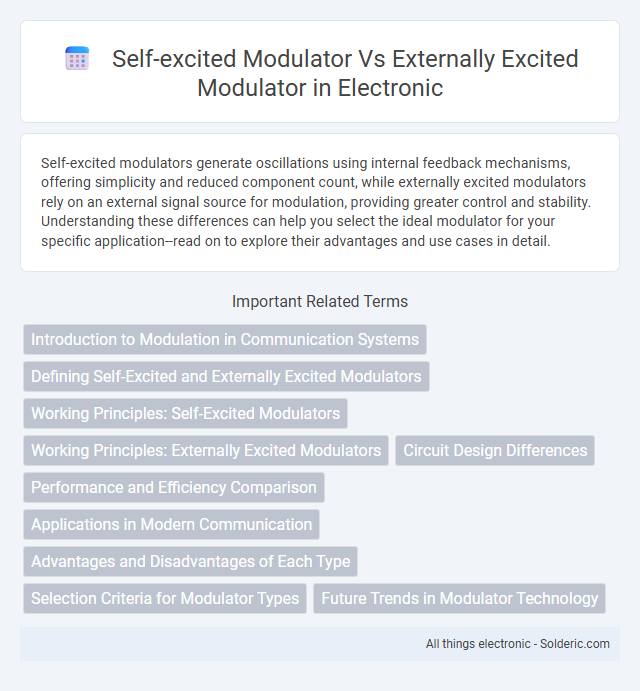Self-excited modulators generate oscillations using internal feedback mechanisms, offering simplicity and reduced component count, while externally excited modulators rely on an external signal source for modulation, providing greater control and stability. Understanding these differences can help you select the ideal modulator for your specific application--read on to explore their advantages and use cases in detail.
Comparison Table
| Feature | Self-Excited Modulator | Externally Excited Modulator |
|---|---|---|
| Excitation Source | Internal feedback loop | Independent external signal |
| Control Flexibility | Limited, depends on internal parameters | High, adjustable via external input |
| Stability | Can be less stable due to self-oscillation | More stable with controlled excitation |
| Application Suitability | Simple, low-cost systems | Precision, high-performance applications |
| Complexity | Lower complexity | Higher complexity due to external components |
| Example Use Cases | Basic power modulators, oscillators | RF modulators, advanced power electronics |
Introduction to Modulation in Communication Systems
Self-excited modulators generate the carrier signal internally, synchronizing modulation by using feedback from the modulated output, which enhances stability and reduces external components. Externally excited modulators rely on an independent carrier source, allowing precise control over carrier frequency and phase, essential for applications demanding high signal fidelity. Understanding these modulator types is crucial in communication systems design to optimize signal quality, bandwidth efficiency, and system complexity.
Defining Self-Excited and Externally Excited Modulators
Self-excited modulators generate their own carrier signal internally through feedback mechanisms, enabling compact design and stable operation without external sources. Externally excited modulators rely on an outside oscillator to supply the carrier frequency, offering more precise control over modulation parameters. Understanding these fundamental differences helps you select the optimal modulator type for your communication or signal processing needs.
Working Principles: Self-Excited Modulators
Self-excited modulators generate their own oscillation signal through internal feedback loops, relying on the energy stored within their components to sustain modulation. They typically use nonlinear elements, such as tunnel diodes or negative resistance devices, to maintain steady oscillations without external RF input. The inherent feedback mechanism allows self-excited modulators to produce high-frequency carrier signals essential for microwave or radar systems.
Working Principles: Externally Excited Modulators
Externally excited modulators operate by receiving a control signal from an independent external source, which drives the modulation process to achieve precise frequency or amplitude adjustments. They use an external oscillator or reference input to maintain stable, accurate modulation parameters, crucial in applications requiring high signal fidelity. This approach contrasts with self-excited modulators, where the modulation frequency is inherently generated within the system, potentially leading to less stability and control.
Circuit Design Differences
Self-excited modulators generate their oscillations internally using feedback loops, simplifying circuit design by eliminating the need for an external signal source, which enhances reliability and reduces component count. Externally excited modulators depend on an external driver signal to control modulation, introducing complexity through additional synchronization circuitry and increased sensitivity to signal integrity. Your choice between these modulators impacts the overall circuit architecture, affecting power efficiency and noise performance in electronic systems.
Performance and Efficiency Comparison
Self-excited modulators generate their driving signals internally, leading to improved synchronization and reduced signal distortion, which enhances overall performance in pulsed power applications. Externally excited modulators rely on an external source for excitation, often resulting in higher complexity and lower efficiency due to signal injection losses and phase instability. Efficiency comparisons typically reveal that self-excited modulators achieve superior energy conversion rates and reduced electromagnetic interference, making them preferable for high-precision, high-power environments.
Applications in Modern Communication
Self-excited modulators are commonly used in radar systems and high-power microwave sources where intrinsic feedback improves signal stability and efficiency in pulse generation. Externally excited modulators find significant applications in fiber-optic communication and satellite transponders due to their precise control over modulation parameters and enhanced signal fidelity. Both modulator types play crucial roles in modern communication networks by optimizing signal strength, bandwidth utilization, and noise reduction.
Advantages and Disadvantages of Each Type
Self-excited modulators generate their own oscillations, offering simplicity and lower component count, which enhances reliability and reduces cost, but they may suffer from less precise frequency control and stability issues. Externally excited modulators provide superior frequency accuracy and stability by using an external reference source, making them suitable for applications requiring high precision, though they are generally more complex and expensive. Your choice depends on whether you prioritize cost-effectiveness and simplicity or precision and control in modulation performance.
Selection Criteria for Modulator Types
Selection criteria for self-excited modulators focus on simplicity, compactness, and reliability in applications where internal feedback can maintain oscillations, making them ideal for low-cost and low-maintenance systems. Externally excited modulators are preferred when precise control of frequency and amplitude is required, often in high-performance or variable-frequency scenarios, due to their dependence on an external source for stable excitation. The choice depends on application-specific factors such as desired signal stability, complexity tolerance, and control requirements.
Future Trends in Modulator Technology
Future trends in modulator technology emphasize enhanced efficiency and miniaturization, with self-excited modulators gaining prominence due to their inherent stability and reduced power consumption. Externally excited modulators continue to evolve by integrating advanced control algorithms that optimize performance under varying operational conditions. Your choice between these technologies will depend on specific application requirements and the balance between cost, control precision, and energy efficiency.
self-excited modulator vs externally excited modulator Infographic

 solderic.com
solderic.com